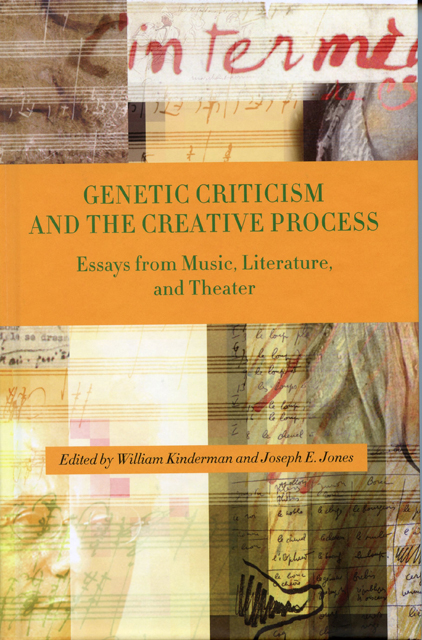Book contents
- Frontmatter
- Contents
- Acknowledgments
- Genetic Criticism and the Creative Process
- 1 Texts, Variants, and Variations: Evolving Contexts in Literature and Theater
- 2 Genetic Processes in Music: From Beethoven to Leroux
- 1 From Varieties of Genetic Experience to Radical Philology
- 2 Variant and Variation: Toward a Freudo-bathmologico-Bakhtino-Goodmanian Genetic Model?
- 3 The Genetic Record of a Voice: Variants in Barthes's Le Plaisir du texte
- 4 Can Genetic Criticism Be Applied to the Performing Arts?
- 5 “The hardy Laurel”: Beckett and Early Film Comedy
- 6 From Melodic Patterns to Themes: The Sketches for the Original Version of Beethoven's “Waldstein” Sonata, Op. 53
- 7 From Conceptual Image to Realization: Some Thoughts on Beethoven's Sketches
- 8 The Process within the Product: Exploratory Transitional Passages in Beethoven's Late Quartet Sketches
- 9 “They Only Give Rise to Misunderstandings”: Mahler's Sketches in Context
- 10 A Study of Richard Strauss's Creative Process: Der Rosenkavalier's “Presentation Scene” and “Schlußduett”
- 11 Genetic Criticism and Cognitive Anthropology: A Reconstruction of Philippe Leroux's Compositional Process for Voi(rex)
- Afterword
- Contributors
- Index
8 - The Process within the Product: Exploratory Transitional Passages in Beethoven's Late Quartet Sketches
Published online by Cambridge University Press: 02 March 2023
- Frontmatter
- Contents
- Acknowledgments
- Genetic Criticism and the Creative Process
- 1 Texts, Variants, and Variations: Evolving Contexts in Literature and Theater
- 2 Genetic Processes in Music: From Beethoven to Leroux
- 1 From Varieties of Genetic Experience to Radical Philology
- 2 Variant and Variation: Toward a Freudo-bathmologico-Bakhtino-Goodmanian Genetic Model?
- 3 The Genetic Record of a Voice: Variants in Barthes's Le Plaisir du texte
- 4 Can Genetic Criticism Be Applied to the Performing Arts?
- 5 “The hardy Laurel”: Beckett and Early Film Comedy
- 6 From Melodic Patterns to Themes: The Sketches for the Original Version of Beethoven's “Waldstein” Sonata, Op. 53
- 7 From Conceptual Image to Realization: Some Thoughts on Beethoven's Sketches
- 8 The Process within the Product: Exploratory Transitional Passages in Beethoven's Late Quartet Sketches
- 9 “They Only Give Rise to Misunderstandings”: Mahler's Sketches in Context
- 10 A Study of Richard Strauss's Creative Process: Der Rosenkavalier's “Presentation Scene” and “Schlußduett”
- 11 Genetic Criticism and Cognitive Anthropology: A Reconstruction of Philippe Leroux's Compositional Process for Voi(rex)
- Afterword
- Contributors
- Index
Summary
In several major works of his last decade, Beethoven wrote passages preceding the finales that might be compared to “composing out loud,” where, in a feigned improvisatory moment, the music pauses as though the invisible protagonist driving it has stopped to gather his or her thoughts before embarking on the final musical action. At times, it is as though Beethoven has inserted a page or two from his sketchbook, or is fancifully staging the creator reviewing his options, in a stylized representation of the decision-making steps of the compositional process. In such passages, Beethoven positions himself like Dante, midway through the journey of his piece, in the middle of a dark wood where the way ahead is lost. He halts, tests ideas, tries alternatives, derives a theme from an earlier one, or draws musical or symbolic connections with something that we have already heard. Examples occur in the Piano Sonata in A, Op. 101, the Cello Sonata in C, Op. 102, no. 1, the Piano Sonata in B Flat, Op. 106, the Ninth Symphony, Op. 125, and the String Quartet in A Minor, Op. 132. In the best-known example, the introduction to the finale of the Ninth Symphony, the most striking feature is not so much what is represented—the brushing aside by the baritone of the three earlier movements—but the change in rhetorical tone that is ushered in at the break between the instrumental exposition and the vocal exposition of the main theme. Beethoven feigns indecisiveness, recalling incipits of the three earlier movements as though casting about for an idea or direction. The moment of decision is marked by a dramatized return to the opening fanfare before the baritone appropriates the earlier double-bass recitative (which Beethoven had asked to be played in time when given to instruments alone) singing the words “O Freunde, nicht diese Töne!” thus not only signaling the path chosen but also embodying it. As the introduction to a finale, each of the examples referred to above could be viewed as extending the traditional practice of “preludizing” before a more structured movement in order to throw weight and significance onto what follows.
- Type
- Chapter
- Information
- Genetic Criticism and the Creative ProcessEssays from Music, Literature, and Theater, pp. 123 - 150Publisher: Boydell & BrewerPrint publication year: 2009

